Ahmad Shah Durrani
Ahmad Shāh Durrānī (c. 1722 – 4 June 1772) (Pashto: احمد شاه دراني), also known as Ahmad Khān Abdālī (احمد خان ابدالي), was the founder of the Durrani Empire and is regarded as the founder of the modern state of Afghanistan.[13][14][15] In July 1747, Ahmad Shah was appointed as the King of Afghanistan by a loya jirga in Kandahar, where he set up his capital.[1] Assisted by a council of nine advisers from various Afghan tribes,[16] Ahmad Shah pushed east towards the Mughal and Maratha Empires of India, west towards the disintegrating Afsharid Empire of Iran, and north towards the Khanate of Bukhara of Turkestan. Within a few years, he extended his control from Khorasan in the west to Kashmir and North India in the east, and from the Amu Darya in the north to the Arabian Sea in the south.[14][17]
| Ahmad Shah Durrani احمد شاه دراني | |||||
|---|---|---|---|---|---|
| Padishah, Ghazi, Shāh Durr-i-Durrān ("King, Pearl of Pearls"), Father of the Nation (Afghanistan) | |||||
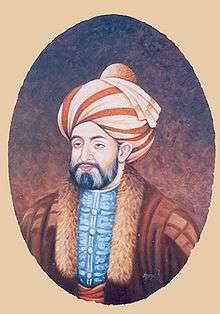 | |||||
| Reign | 1747–1772 | ||||
| Coronation | July 1747[1] | ||||
| Predecessor | Hussain Hotak | ||||
| Successor | Timur Shah Durrani | ||||
| Born | c. 1722 Herat, Hotak Empire (present-day Afghanistan)[2][3][4][5] or Multan, Mughal Empire (present-day Pakistan)[6][7][8][9][10] | ||||
| Died | (aged 50)[11] Maruf, Kandahar Province, Durrani Empire | ||||
| Burial | |||||
| Spouse | Hazrat Begum Iffat-un-Nissa Begum | ||||
| |||||
| Dynasty | Durrani | ||||
| Father | Muhammad Zaman Khan Abdali | ||||
| Mother | Zarghuna Ana[12] | ||||
| Religion | Sunni Islam | ||||
Soon after accession, Ahmad Shah adopted the epithet Shāh Durr-i-Durrān, "King, Pearl of Pearls," and changed the name of his Abdali tribe to "Durrani" after himself. The Tomb of Ahmad Shah Durrani is located in the center of Kandahar, adjacent to the Shrine of the Cloak, which contains a cloak believed to have been worn by the Islamic prophet Muhammad. Afghans often refer to Ahmad Shah as Ahmad Shāh Bābā, "Ahmad Shah the Father".[13][18][19][20]
Early years
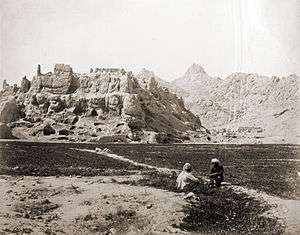
Durrani was born in Herat (then Hotak Empire, present-day Afghanistan)[21][22][23] or Multan (then Mughal Empire, present-day Pakistan)[24][25][26][27] in 1722 to Mohammad Zaman Khan, chief of the Abdali tribe and Governor of Herat, and Zarghuna Ana, daughter of Khalu Khan Alkozai.
Durrani's forefathers were Sadozais but his mother was from the Alakozai tribe. In June 1729, the Abdali forces under Zulfiqar had surrendered to Nader Shah Afshar, the rising new ruler of Persia. However, they soon began a rebellion and took over Herat as well as Mashad. In July 1730, he defeated Ibrahim Khan, a military commander and brother of Nader Shah. This prompted Nader Shah to retake Mashad and also intervene in the power struggle of Harat. By July 1731, Zulfiqar returned to his capital Farah where he had been serving as the governor since 1726. A year later Nadir's brother Ibrahim Khan took control of Farah. During this time Zulfiqar and the young Durrani fled to Kandahar where they took refuge with the Ghiljis. They were later made political prisoners by Hussain Hotak, the Ghilji ruler of the Kandahar region.[28]
Nader Shah had been enlisting the Abdalis in his army since around 1729. After conquering Kandahar in 1738, Durrani and his brother Zulfiqar were freed and provided with leading careers in Nader Shah's administration. Zulfiqar was made Governor of Mazandaran while Durrani remained working as Nader Shah's personal attendant. The Ghiljis, who are originally from the territories east of the Kandahar region, were expelled from Kandahar in order to resettle the Abdalis along with some Qizilbash and other Persians.[29]
Durrani proved himself in Nader Shah's service and was promoted from a personal attendant (yasāwal) to command the Abdali Regiment, a cavalry of four thousand soldiers and officers. The Abdali Regiment was part of Nader Shah's military during his invasion of the Mughal Empire in 1738.[30]
Popular history has it that the Shah could see the talent in his young commander. Later on, according to Pashtun legend, it is said that in Delhi Nader Shah summoned Durrani, and said, "Come forward Ahmad Abdali. Remember Ahmad Khan Abdali, that after me the Kingship will pass on to you.[31] Nader Shah recruited him because of his "impressive personality and valour" also because of his "loyalty to the Persian monarch".[32]
Rise to power
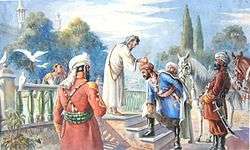
Nader Shah's rule abruptly ended in June 1747 when he was assassinated by his own guards. The guards involved in the assassination did so secretly so as to prevent the Abdalis from coming to their King's rescue. However, Durrani was told that the Shah had been killed by one of his wives. Despite the danger of being attacked, the Abdali contingent led by Durrani rushed either to save the Shah or to confirm what happened. Upon reaching the Shah's tent, they were only to see his body and severed head. Having served him so loyally, the Abdalis wept at having failed their leader,[33] and headed back to Kandahar. Before the retreat to Kandahar, he had "removed" the royal seal from Nader Shah's finger and the Koh-i-Noor diamond tied "around the arm of his deceased master". On their way back to Kandahar, the Abdalis had "unanimously accepted" Durrani as their new leader. Hence he "assumed the insignia of royalty" as the "sovereign ruler of Afghanistan".[34]
At the time of Nadir's death, he commanded a contingent of Abdali Pashtuns. Realizing that his life was in jeopardy if he stayed among the Persians who had murdered Nader Shah, he decided to leave the Persian camp, and with his 4,000 troops he proceeded to Qandahar. Along the way and by sheer luck, they managed to capture a caravan with booty from India. He and his troops were rich; moreover, they were experienced fighters. In short, they formed a formidable force of young Pashtun soldiers who were loyal to their high-ranking leader.[35]
One of Durrani's first acts as chief was to adopt the epithet Shāh Durr-i-Durrān, "King, Pearl of Pearls."[13]
Forming the last Afghan empire
Although Ahmad Shah appointed his fellow Durrani (Abdali) clansmen for most senior military posts, his army was otherwise ethnically diverse with soldiers also from various other ethnic and tribal groups, including non-Durrani Pashtun tribes like the Ghilji, and non-Pashtun groups such as Qizilbash, Hazaras, Tajiks, Uzbeks, and Baloch.[29] He began his military conquest by capturing Qalati Ghilji from its governor Ashraf Tokhi, and then captured Ghazni, where he installed his own governor after some fighting. Ahmad then wrestled Kabul and Peshawar from Mughal-appointed governor Nasir Khan, and conquered the area up to the Indus River. On 15 July 1747, Durrani appointed Muhammad Hashim Afridi as chief of the Afridi of Peshawar.[1][34] He conquered Herat in 1750 and Kashmir in 1752.[36]
Indian invasions
Early invasions
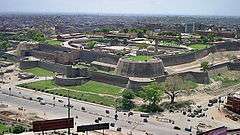
Peshawar served as a convenient point for Ahmad Shah for his military conquests in Hindustan. From 1748 to 1767, he invaded Hindustan eight times. He first crossed the Indus River in 1748, the year after his ascension – his forces sacked and absorbed Lahore. In 1749, Ahmad Shah captured the area of Punjab around Lahore. In the same year, the Mughal ruler was induced to cede Sindh and all of the Punjab including the vital trans-Indus River to him, in order to save his capital from being attacked by the forces of the Durrani Empire. Having thus gained substantial territories to the east without a fight, Durrani and his forces turned westward to take possession of Herat, which was ruled by Nader Shah's grandson, Shah Rukh. The city fell to the Afghans in 1750, after almost a year of siege and bloody conflict; the Afghan forces then pushed on into present-day Iran, capturing Nishapur and Mashhad in 1751.[37] Following the recapture of Mashhad in 1754, Durrani visited the eighth Imam's sepulchre and ordered repairs to be made.[37] Durrani then pardoned Shah Rukh and reconstituted Khorasan, but a tributary of the Durrani Empire. This marked the westernmost border of the Afghan Empire as set by the Pul-i-Abrisham, on the Mashhad-Tehran road.[38]
Third battle of Panipat

The Mughal power in northern India had been declining since the reign of Aurangzeb, who died in 1707. In 1751–52, the Ahamdiya treaty was signed between the Marathas and Mughals, when Balaji Bajirao was the Peshwa of the Maratha Empire.[39] Through this treaty, the Marathas controlled large parts of India from their capital at Pune and Mughal rule was restricted only to Delhi (Mughals remained the nominal heads of Delhi). Marathas were now straining to expand their area of control towards the Northwest of India. Durrani sacked the Mughal capital and withdrew with the booty he coveted. To counter the Afghans, Peshwa Balaji Bajirao sent Raghunathrao. He succeeded in ousting Timur Shah and his court from India and brought northwest of India up to Peshawar under Maratha rule.[40] Thus, upon his return to Kandahar in 1757, Durrani chose to return to India and confront the Maratha forces to regain northwestern part of the subcontinent.
In 1761, Durrani set out on his campaign to win back lost territories. The early skirmishes ended in victory for the Afghans against the Maratha garrisons in northwest India. By 1759, Durrani and his army had reached Lahore and were poised to confront the Marathas. By 1760, the Maratha groups had coalesced into a big enough army under the command of Sadashivrao Bhau. Once again, Panipat was the scene of a battle for control of northern India. The Third battle of Panipat was fought between Durrani's Afghan forces and the Maratha forces in January 1761, and resulted in a decisive Durrani victory.[41]
Central Asia
The historical area of what is modern day Xinjiang consisted of the distinct areas of the Tarim Basin and Dzungaria, and was originally populated by Indo-European Tocharian and Eastern Iranian Saka peoples who practiced the Buddhist religion. The area was subjected to Turkification and Islamification at the hands of invading Turkic Muslims. Both the Buddhist Turkic Uyghurs and Muslim Turkic Karluks participated in the Turkification and conquest of the native Buddhist Indo-European inhabitants of the Tarim Basin. The Turkic Muslims then proceeded to conquer the Turkic Buddhists in Islamic holy wars and converted them to Islam. The mixture between the invading Mongoloid Turkic peoples and the native Caucasian Indo-European inhabitants resulted in the modern day Turkic speaking hybrid Europoid-East Asian inhabitants of Xinjiang. The Turkification was carried out in the 9th and 10th centuries by two different Turkic Kingdoms, the Buddhist Uyghur Kingdom of Qocho and the Muslim Karluk Kara-Khanid Khanate. Halfway in the 10th century the Saka Iranic Buddhist Kingdom of Khotan came under attack by the Turkic Muslim Karakhanid ruler Musa, and in what proved to be a pivotal moment in the Turkification and Islamification of the Tarim Basin, the Karakhanid leader Yusuf Qadir Khan conquered Khotan around 1006.[42]
Professor James A. Millward described the original Uyghurs as physically Mongoloid, giving as an example the images in Bezeklik at temple 9 of the Uyghur patrons, until they began to mix with the Tarim Basin's original eastern Iranian inhabitants.[43] The modern Uyghurs are now a mixed hybrid of East Asian and Europoid populations.[44][45][46] The Turkic Muslim sedentary people of the Tarim Basin of Altishahr were originally ruled by the Chagatai Khanate while the nomadic Buddhist Dzungar Oirats in Dzungaria ruled over the Dzungar Khanate. The Naqshbandi Sufi Khojas, descendants of the Prophet Muhammad, had replaced the Chagatayid Khans as the ruling authority of the Tarim Basin in the early 17th century. There was a struggle between two factions of Khojas, the Afaqi (White Mountain) faction and the Ishaqi (Black Mountain) faction. The Ishaqi defeated the Afaqi, which resulted in the Afaqi Khoja inviting the 5th Dalai Lama, the leader of the Tibetan Buddhists, to intervene on his behalf in 1677. The 5th Dalai Lama then called upon his Dzungar Buddhist followers in the Zunghar Khanate to act on this invitation. The Dzungar Khanate then conquered the Tarim Basin in 1680, setting up the Afaqi Khoja as their puppet ruler.
Khoja Afaq asked the 5th Dalai Lama when he fled to Lhasa to help his Afaqi faction take control of the Tarim Basin (Kashgaria).[47] The Dzungar leader Galdan was then asked by the Dalai Lama to restore Khoja Afaq as ruler of Kashgararia.[48] Khoja Afaq collaborated with Galdan's Dzungars when the Dzungars conquered the Tarim Basin from 1678–1680 and set up the Afaqi Khojas as puppet client rulers.[49][50][51][52] The Dalai Lama blessed Galdan's conquest of the Tarim Basin and Turfan Basin.[53]
Since 1680 the Dzungars had ruled as suzerain masters over the Tarim, for 16 more years using the Chagatai as their puppet rulers. The Dzungars used a hostage arrangement to rule over the Tarim Basin, keeping as hostages in Ili either the sons of the leaders like the Khojas and Khans or the leaders themselves. Although the Uighur's culture and religion was left alone, the Dzungars substantially exploited them economically .[54] The Uighurs were forced with multiple taxes by the Dzungars which were burdensome and set by a determined amount, and which they did not even have the ability to pay. They included water conservancy tax, draught animal tax, fruit tax, poll tax, land tax, tress and grass tax, gold and silver tax, and trade tax. Annually the Dzungars extracted a tax of 67,000 tangas of silver from the Kashgar people in Galdan Tseren's reign, a five percent tax was imposed on foreign traders and a ten percent tax imposed on Muslim merchants, people had to pay a fruit tax if they owned orchards and merchants had to pay a copper and silver tax. Annually the Dzungars extracted 100,000 silver tangas in tax from Yarkand and slapped livestock, stain, commerce, and a gold tax on them. The Dzungars extracted 700 taels of gold, and also extracted cotton, copper, and cloth, from the six regions of Keriya, Kashgar, Khotan, Kucha, Yarkand, and Aksu as stated by Russian topographer Yakoff Filisoff. The Dzungars extracted over 50% of the wheat harvests of Muslims according to Qi-yi-shi (Chun Yuan), 30–40% of the wheat harvests of Muslims according to the Xiyu tuzhi, which labelled the tax as "plunder" of the Muslims. The Dzungars also extorted extra taxes on cotton, silver, gold, and traded goods from the Muslims besides making them pay the official tax. "Wine, meat, and women" and "a parting gift" were forcibly extracted from the Uighurs daily by the Dzungars who went to physically gather the taxes from the Uighur Muslims, and if they dissatisfied with what they received, they would rape women, and loot and steal property and livestock. Gold necklaces, diamonds, pearls, and precious stones from India were extracted from the Uighurs under Dāniyāl Khoja by Tsewang Rabtan when his daughter was getting married.[55]
67,000 patman (each patman is 4 piculs and 5 pecks) of grain 48,000 silver ounces were forced to be paid yearly by Kashgar to the Dzungars and cash was also paid by the rest of the cities to the Dzungars. Trade, milling, and distilling taxes, corvée labor, saffron, cotton, and grain were also extracted by the Dzungars from the Tarim Basin. Every harvest season, women and food had to be provided to Dzungars when they came to extract the taxes from them.[56]
When the Dzungars levied the traditional nomadic Alban poll tax upon the Muslims of Altishahr, the Muslims viewed it as the payment of jizyah (a tax traditionally taken from non-Muslims by Muslim conquerors).[57]
The Qing defeat of the Dzungars went hand in hand with the anti-Dzungar resistance of the ordinary Uighurs, "many of them, unable to bear their misery, which was like living in a sea of fire, fled but were not able to find a place to settle peacefully." The Uighurs carried out "acts of resistance" like hiding the goods which were collected as taxes or violently resisting the Dzungar Oirat tax collectors, but these incidents were infrequent and widespread anti-Dzungar opposition failed to materialize. Many opponents of Dzungar rule like Uighurs and some dissident Dzungars escaped and defected to Qing China during 1737–1754 and provided the Qing with intelligence on the Dzungars and voiced their grievances. Abdullāh Tarkhān Beg and his Hami Uighurs defected and submitted to Qing China after the Qing inflicted a devastating defeat at Chao-mo-do on the Dzungar leader Galdan in September 1696.[58] The Uighur leader Emin Khoja (Amīn Khoja) of Turfan revolted against the Dzungars in 1720 while the Dzungars under Tsewang Rabtan were being attacked by the Qing, and then he also defected and submitted to the Qing. The Uighurs in Kashgar under Yūsuf and his older brother Jahān Khoja of Yarkand revolted in 1754 against the Dzungars, but Jahān was taken prisoner by the Dzungars after he was betrayed by the Uch-Turfan Uighur Xi-bo-ke Khoja and Aksu Uighur Ayyūb Khoja. Kashgar and Yarkand were assaulted by 7,000 Khotan Uighurs under Sādiq, the son of Jahān Khoja. The Uighurs supported the 1755 Qing assault against the Dzungars in Ili, which occurred at the same time as the Uighur revolts against the Dzungars. Uighurs like Emin Khoja, 'Abdu'l Mu'min and Yūsuf Beg supported the Qing attack against Dawachi, the Dzungar Khan.[59] The Uch-Turfan UighurnBeg Khojis (Huojisi) supported the Qing General Ban-di against in tricking Davachi and taking him prisoner. The Qing and Amin Khoja and his sons worked together to defeat the Dzungars under Amursana.[60]
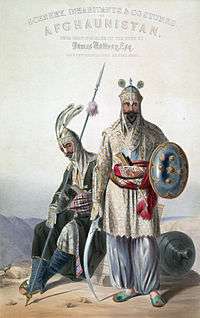
From the 17th century to the middle of the 18th century, between China proper and Transoxania, all the land was under the sway of the Dzungars. In Semirechye the Kyrgyz and Kazakahs were forcibly driven out by the Dzungars and the Kashgar Khanate was conquered. However, the Dzungar Empire was annihilated by Qing China from 1755–1758 in a formidable assault, ending the Central Asian states danger from the Dzungar menace.[61] Uighur Muslims like Emin Khoja from Turfan revolted against their Dzungar Buddhist rulers and pledged allegiance to Qing China to deliver them from Dzungar Buddhist rule. The Qing crushed and annihilated the Dzungars in the Dzungar genocide.
The Dzungar Buddhists brought back the Aqtaghliq Afaqi Khoja Burhan-ud-din and his brother Khan Khoja and installed them as puppet rulers in Kashgar. During the Qing's war against the Dzungars, Burhan-ud-din and his brother Khan Khoja then pledged allegiance to Qing China in exchange for delivering them from Dzungar rule. However, after the Qing defeated the Dzungars, the Afaqi Khoja brothers Burhan-ud-din and Khan Khoja reneged on the deal with the Qing, declared independence and revolted against the Qing. The Qing and loyal Uighurs like Emin Khoja crushed the revolt and drove Burhan-ud-din and Khan Khoja to Badakhshan. The Qing armies reached far in Central Asia and came to the outskirts of Tashkent while the Kazakh rulers made their submissions as vassals to the Qing.[62] The Afaqi brothers died in Badakhshan and the ruler Sultan Shah delivered their bodies to the Qing. Ahmad Shah Durrani accused Sultan Shah of having caused the Afaqi brothers to die.[63]
Durrani dispatched troops to Kokand after rumours that the Qing dynasty planned to launch an expedition to Samarkand, but the alleged expedition never happened and Ahmad Shah subsequently withdrew his forces when his attempt at an anti-Qing alliance among Central Asian states failed.[64] Durrani then sent envoys to Beijing to discuss the situation regarding the Afaqi Khojas.[65]
Rise of the Sikhs in the Punjab
During the Third Battle of Panipat between Marathas and Durrani, the Sikhs did not engage along with the Marathas and hence are considered neutral in the war. This was because of the flawed diplomacy on the part of Marathas in not recognizing their strategic potential. The exception was Ala Singh of Patiala, who sided with the Afghans and was actually being granted and coincidentally crowned the first Sikh Maharajah at the Sikh holy temple.[66]
Death and legacy
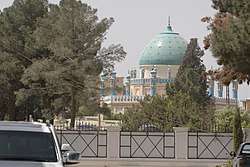
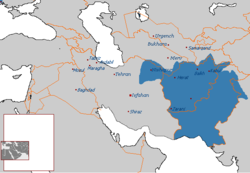
Durrani died of his illness on 4 June 1772 in Maruf, Kandahar Province.[11] He was buried in the city of Kandahar adjacent to the Shrine of the Cloak, where a large mausoleum was built. It has been described in the following way:
Under the shimmering turquoise dome that dominates the sand-blown city of Kandahar lies the body of Ahmad Shah Abdali, the young Kandahari warrior who in 1747 became the region's first Durrani king. The mausoleum is covered in deep blue and white tiles behind a small grove of trees, one of which is said to cure toothache, and is a place of pilgrimage. In front of it is a small mosque with a marble vault containing one of the holiest relics in the Islamic World, a kherqa, the Sacred Cloak of Mohammed that was given to Ahmad Shah by Mured Beg, the Emir of Bokhara. The Sacred Cloak is kept locked away, taken out only at times of great crisis but the mausoleum is open and there is a constant line of men leaving their sandals at the door and shuffling through to marvel at the surprisingly long marble tomb and touch the glass case containing Ahmad Shah's brass helmet. Before leaving they bend to kiss a length of pink velvet said to be from his robe. It bears the unmistakable scent of jasmine.[67]
In his tomb his epitaph is written:
The King of high rank, Ahmad Shah Durrani,
Was equal to Kisra in managing the affairs of his government.
In his time, from the awe of his glory and greatness,
The lioness nourished the stag with her milk.
From all sides in the ear of his enemies there arrived
A thousand reproofs from the tongue of his dagger.
The date of his departure for the house of mortality
Was the year of the Hijra 1186 (1772 A.D.)[68]
Durrani's victory over the Marathas influenced the history of the subcontinent and, in particular, British policy in the region. His refusal to continue his campaigns deeper into India prevented a clash with the East India Company and allowed them to continue to acquire power and influence after they took complete control of the former Mughal province of Bengal in 1793. However, fear of another Afghan invasion was to haunt British policy for almost half a century after the battle of Panipat. The acknowledgment of Abdali's military accomplishments is reflected in a British intelligence report on the Battle of Panipat, which referred to Ahmad Shah as the 'King of Kings'.[69] This fear led in 1798 to a British envoy being sent to the Persian court in part to instigate the Persians in their claims on Herat to forestall an Afghan invasion of India that might have halted British East India company's expansion.[69] Mountstuart Elphinstone wrote of Ahmad Shah:
His military courage and activity are spoken of with admiration, both by his own subjects and the nations with whom he was engaged, either in wars or alliances. He seems to have been naturally disposed to mildness and clemency and though it is impossible to acquire sovereign power and perhaps, in Asia, to maintain it, without crimes; yet the memory of no eastern prince is stained with fewer acts of cruelty and injustice.
His successors, beginning with his son Timur and ending with Shuja Shah Durrani, proved largely incapable of governing the last Afghan empire and faced with advancing enemies on all sides. Much of the territory conquered by Ahmad Shah fell to others by the end of the 19th century. They not only lost the outlying territories but also alienated some Pashtun tribes and those of other Durrani lineages. Until Dost Mohammad Khan's ascendancy in 1826, chaos reigned in Afghanistan, which effectively ceased to exist as a single entity, disintegrating into a fragmented collection of small countries or units. This policy ensured that he did not continue on the path of other conquerors like Babur or Muhammad of Ghor and make India the base for his empire.
In Pakistan, a short-range ballistic missile Abdali-I, is named in the honour of Ahmed Shah Abdali.[70]
The film Panipat, has Ahmad Shah Durrani being played by Bollywood actor; Sanjay Dutt.
Durrani's poetry
Durrani wrote a collection of odes in his native Pashto language. He was also the author of several poems in Persian. The most famous Pashto poem he wrote was Love of a Nation:
By blood, we are immersed in love of you.
The youth lose their heads for your sake.
I come to you and my heart finds rest.
Away from you, grief clings to my heart like a snake.
I forget the throne of Delhi
when I remember the mountain tops of my beautiful Pakhtunkhwa.
If I must choose between the world and you,
I shall not hesitate to claim your barren deserts as my own.[71][72]
ستا د عشق له مينی ډک شول ځيګرونه [73]
Sta de ishq de weeno daq sho zegaronah
ستا په لاره کـــې بايلــــــــي ځلمي سرونه
Sta puh meena ke byley zalmey saronah
تاته راشمــــه زړګــــی زمــــا فـــارغ شي
Ta tuh reshema zergai ze mai farigh shey
بې له تا مــــې انديښنې د زړه مارونه
Bey ley ta mai andekhney de zlar maronah
که هــــر څه مې د دنيا ملکونه ډير شي
Ke har sa mi de dunia molkona der shi
زما به هير نه شي دا ستا ښکلي باغونه
ze ma ba heera na shi da sta shekeli baghona
I will not forget it your beautiful gardens
د ډيلـــي تخت هيرومه چې را ياد کړم
De Delhi takht hayrawoona chey rayad kum
زما د ښکلي پښتونخوا د غرو سرونه
Ze mah de khekely or shekele Pakhtunkhwa de ghru saronah
Personal life
During Nader Shah's invasion of India in 1739, Abdali also accompanied him and stayed some days in the Red Fort of Delhi. When he was standing "outside the Jali gate near Diwan-i-Am", Asaf Jah I saw him. He was "an expert in physiognomy" and predicted that Abdali was "destined to become a king". When Nader Shah came to know about it, he "purportedly clipped" his ears with his dagger and made the remark "When you become a king, this will remind you of me". According to other sources, Nader Shah did not believe in it and asked him to be kind to his descendants "on the attaintment of royalty".[32]
| Family tree | ||||||||||||||||||||||||||||||||||||||||||||||||||||||||||||||||||||||||||||||||||||||||||||||||||||||||||||||||||||||||||||||||||||||||||||||||||||||||||||||||||||||||||||||||||||||||
|---|---|---|---|---|---|---|---|---|---|---|---|---|---|---|---|---|---|---|---|---|---|---|---|---|---|---|---|---|---|---|---|---|---|---|---|---|---|---|---|---|---|---|---|---|---|---|---|---|---|---|---|---|---|---|---|---|---|---|---|---|---|---|---|---|---|---|---|---|---|---|---|---|---|---|---|---|---|---|---|---|---|---|---|---|---|---|---|---|---|---|---|---|---|---|---|---|---|---|---|---|---|---|---|---|---|---|---|---|---|---|---|---|---|---|---|---|---|---|---|---|---|---|---|---|---|---|---|---|---|---|---|---|---|---|---|---|---|---|---|---|---|---|---|---|---|---|---|---|---|---|---|---|---|---|---|---|---|---|---|---|---|---|---|---|---|---|---|---|---|---|---|---|---|---|---|---|---|---|---|---|---|---|---|---|
| ||||||||||||||||||||||||||||||||||||||||||||||||||||||||||||||||||||||||||||||||||||||||||||||||||||||||||||||||||||||||||||||||||||||||||||||||||||||||||||||||||||||||||||||||||||||||
See also
- List of monarchs of Afghanistan
References
- [...] "Aḥmad Shāh issued a royal edict on 15 July 1747, appointing Muḥammad Hāshim Afrīdī as chief of the Afrīdī of the Peshawar region. This appears to affirm that Aḥmad Shāh’s accession took place no later than mid-July..." The Pearl of Pearls: The Abdālī-Durrānī Confederacy and Its Transformation under Aḥmad Shāh, Durr-i Durrān by Sajjad Nejatie. https://tspace.library.utoronto.ca/handle/1807/80750.
- [...] "there is little reliable evidence of Aḥmad’s birth in Multan. Works dedicated to the Sadōzay of Multan, like the Zubdat al-akhbār and Taẕkirat al-mulūk-i ʿālī-shān, do not mention Aḥmad’s birth there. In fact, the bulk of sources dating from the lifetime of Aḥmad Shāh point to Herat as his birthplace. Maḥmūd al-Ḥusaynī, for instance, who mentions Zamān Khān’s rule in Herat and Aḥmad’s upbringing in Khurasan, says nothing of his birth in Multan". The Pearl of Pearls: The Abdālī-Durrānī Confederacy and Its Transformation under Aḥmad Shāh, Durr-i Durrān by Sajjad Nejatie. https://tspace.library.utoronto.ca/handle/1807/80750.
- "Further indication that Aḥmad’s birth occurred in the Herat region may be found in another contemporary source, the Shāhnāma-i Aḥmadī by Niẓām al-Dīn “ʿIshrat” from the town of Siyālkōt in the Punjab, which includes the following verses of poetry:
The inclusion of this verse in the section on Aḥmad Shāh’s birth (tawlīd) would indicate that the bounty (māya) mentioned therein is reference to none other than Zamān Khān’s son, Aḥmad, whom the poet describes as the product of the water of life (āb-i ḥayāt)— often used as a metaphor for semen—that is responsible for giving new life to what had been the “lifeless” land of Herat. That this verse is, indeed, a reference to Aḥmad is confirmed a few lines later where Niẓām al-Dīn writes about Zamān Khān: His throne was more splendid than any other ruler’s Because Aḥmad possessed night-illuminating radiance His breast was happy on account of this budding rose [i.e., Aḥmad] While the hearts of his enemies bore the brand [of sorrow] like the tulip". The Pearl of Pearls: The Abdālī-Durrānī Confederacy and Its Transformation under Aḥmad Shāh, Durr-i Durrān by Sajjad Nejatie. https://tspace.library.utoronto.ca/handle/1807/80750
Since through the Creator’s cloud of beneficence
Muḥammad Zamān Khān had become bountiful
The lifeless mountains and plains of Herat
Were again restored through the water of life
chū az abr-i iḥsān-i parwardigār
Muḥammad Zamān Khān shuda māya-dār
zamīn murda-i kōh o dasht-i Harāt
digar tāza-jān shud zi āb-i ḥayāt - "In continuing the imagery of Herat being given renewed vitality on account of Aḥmad’s auspicious birth, Niẓām al-Dīn likens his patron to a budding rose who was a source of happiness for Zamān but the cause of sorrow and grief for his enemies. What is noteworthy about early Durrānī-era sources such as the Tārīkh-i Aḥmad Shāhī and Shāhnāma-i Aḥmadī is that their authors repeatedly link Aḥmad to Herat and neglect to mention his birth in Multan". The Pearl of Pearls: The Abdālī-Durrānī Confederacy and Its Transformation under Aḥmad Shāh, Durr-i Durrān by Sajjad Nejatie. https://tspace.library.utoronto.ca/handle/1807/80750
- A Concise History of Afghanistan. Hamid Wahed Alikuzai. 2005. p. 204. ISBN 9781490714417. Retrieved 12 November 2019.
Durrani was born as Ahmad Shah in 1722 in the city of Herat in modern Afghanistan
- Nichols, Robert (2015). "Aḥmad Shāh Durrānī". In Fleet, Kate; Krämer, Gudrun; Matringe, Denis; Nawas, John; Rowson, Everett (eds.). Encyclopaedia of Islam, THREE. doi:10.1163/1573-3912_ei3_COM_24801. ISSN 1873-9830.
Aḥmad Shāh Durrānī (r. 1160–86/1747–72), of the Sadozay section of the Popalzay lineage of the Abdālī Afghans, was the first Sadozay ruler of Afghanistan, founding the Durrānī empire in 1160/1747. Born in Multān (which was disputed with Herat) as Aḥmad Khān, second son of Zamān Khān Abdālī (d. 1135/1722), then governor of Herat, he arose from the lineage, regional, and imperial competitions of the age to establish an independent Afghan power.
- Hanifi, Shah Mahmoud (2008). Connecting Histories in Afghanistan: Market Relations and State Formation on a Colonial Frontier. Stanford, California: Stanford University Press. p. 42. ISBN 978-0804777773.
Ahmad Shah (ruled 1747–72), the ephemeral empire's founder, was born in Multan in 1722.
- Roy, Kaushik; Lorge, Peter, eds. (2015). Chinese and Indian Warfare – From the Classical Age to 1870. Routledge. p. 95. ISBN 978-1317587101.
Ahmad Khan later known as Ahmad Shah Durrani/Abdali was born in 1722 at Multan.
- Mehta, J. L. (2005). Advanced study in the history of modern India 1707–1813. Sterling Publishers Pvt. Ltd. p. 247. ISBN 978-1-932705-54-6. Retrieved 23 September 2010.
- Dalrymple, William (2013). Return of a King: The battle for Afghanistan. Bloomsbury Publishing. ISBN 978-1408818305.
Ahmad Shah Abdali (1722–72): Born in Multan, Ahmad Shah rose to power in the service of the Persian warlord Nadir Shah.
- [...] "he succumbed to his illness on 2 Rabīʿ I 1186/4 June 1772". The Pearl of Pearls: The Abdālī-Durrānī Confederacy and Its Transformation under Aḥmad Shāh, Durr-i Durrān by Sajjad Nejatie. https://tspace.library.utoronto.ca/handle/1807/80750.
- "Afghan first lady in shadow of 1920s queen?". 1 October 2014 – via www.aljazeera.com.
- "Ahmad Shah and the Durrani Empire". Library of Congress Country Studies on Afghanistan. 1997. Retrieved 23 September 2010.
- Friedrich Engels (1857). "Afghanistan". Andy Blunden. The New American Cyclopaedia, Vol. I. Archived from the original on 18 October 2010. Retrieved 23 September 2010.
- Clements, Frank (2003). Conflict in Afghanistan: a historical encyclopedia. ABC-CLIO. p. 81. ISBN 978-1-85109-402-8. Retrieved 23 September 2010.
- "Aḥmad Shah Durrānī". Encyclopædia Britannica. Retrieved 4 June 2020.
- Chayes, Sarah (2006). The Punishment of Virtue: Inside Afghanistan After the Taliban. Univ. of Queensland Press. p. 99. ISBN 978-1-932705-54-6. Retrieved 23 September 2010.
- Singh, Ganḍā (1959). Ahmad Shah Durrani: Father of Modern Afghanistan. Asia Publishing House. p. 457. ISBN 978-1-4021-7278-6. Retrieved 25 August 2010.
- "Ahmad Shah Abdali". Abdullah Qazi. Afghanistan Online. Archived from the original on 12 August 2010. Retrieved 23 September 2010.
Afghans refer to him as Ahmad Shah Baba (Ahmad Shah, the father).
- Runion, Meredith L. (2007). The history of Afghanistan. Greenwood Publishing Group. p. 71. ISBN 978-0-313-33798-7. Retrieved 23 September 2010.
- [...] "there is little reliable evidence of Aḥmad’s birth in Multan. Works dedicated to the Sadōzay of Multan, like the Zubdat al-akhbār and Taẕkirat al-mulūk-i ʿālī-shān, do not mention Aḥmad’s birth there. In fact, the bulk of sources dating from the lifetime of Aḥmad Shāh point to Herat as his birthplace. Maḥmūd al-Ḥusaynī, for instance, who mentions Zamān Khān’s rule in Herat and Aḥmad’s upbringing in Khurasan, says nothing of his birth in Multan". The Pearl of Pearls: The Abdālī-Durrānī Confederacy and Its Transformation under Aḥmad Shāh, Durr-i Durrān by Sajjad Nejatie. https://tspace.library.utoronto.ca/handle/1807/80750.
- "Further indication that Aḥmad’s birth occurred in the Herat region may be found in another contemporary source, the Shāhnāma-i Aḥmadī by Niẓām al-Dīn “ʿIshrat” from the town of Siyālkōt in the Punjab, which includes the following verses of poetry: Since through the Creator’s cloud of beneficence Muḥammad Zamān Khān had become bountiful The lifeless mountains and plains of Herat Were again restored through the water of life chū az abr-i iḥsān-i parwardigār Muḥammad Zamān Khān shuda māya-dār zamīn murda-i kōh o dasht-i Harāt digar tāza-jān shud zi āb-i ḥayāt The inclusion of this verse in the section on Aḥmad Shāh’s birth (tawlīd) would indicate that the bounty (māya) mentioned therein is reference to none other than Zamān Khān’s son, Aḥmad, whom the poet describes as the product of the water of life (āb-i ḥayāt)—often used as a metaphor for semen—that is responsible for giving new life to what had been the “lifeless” land of Herat. That this verse is, indeed, a reference to Aḥmad is confirmed a few lines later where Niẓām al-Dīn writes about Zamān Khān: His throne was more splendid than any other ruler’s Because Aḥmad possessed night-illuminating radiance His breast was happy on account of this budding rose [i.e., Aḥmad] While the hearts of his enemies bore the brand [of sorrow] like the tulip". The Pearl of Pearls: The Abdālī-Durrānī Confederacy and Its Transformation under Aḥmad Shāh, Durr-i Durrān by Sajjad Nejatie. https://tspace.library.utoronto.ca/handle/1807/80750
- "In continuing the imagery of Herat being given renewed vitality on account of Aḥmad’s auspicious birth, Niẓām al-Dīn likens his patron to a budding rose who was a source of happiness for Zamān but the cause of sorrow and grief for his enemies. What is noteworthy about early Durrānī-era sources such as the Tārīkh-i Aḥmad Shāhī and Shāhnāma-i Aḥmadī is that their authors repeatedly link Aḥmad to Herat and neglect to mention his birth in Multan". The Pearl of Pearls: The Abdālī-Durrānī Confederacy and Its Transformation under Aḥmad Shāh, Durr-i Durrān by Sajjad Nejatie. https://tspace.library.utoronto.ca/handle/1807/80750
- Nichols, Robert (2015). "Aḥmad Shāh Durrānī". In Fleet, Kate; Krämer, Gudrun; Matringe, Denis; Nawas, John; Rowson, Everett (eds.). Encyclopaedia of Islam, THREE. doi:10.1163/1573-3912_ei3_COM_24801. ISSN 1873-9830.
Aḥmad Shāh Durrānī (r. 1160–86/1747–72), of the Sadozay section of the Popalzay lineage of the Abdālī Afghans, was the first Sadozay ruler of Afghanistan, founding the Durrānī empire in 1160/1747. Born in Multān (which was disputed with Herat) as Aḥmad Khān, second son of Zamān Khān Abdālī (d. 1135/1722), then governor of Herat, he arose from the lineage, regional, and imperial competitions of the age to establish an independent Afghan power.
- Hanifi, Shah Mahmoud (2008). Connecting Histories in Afghanistan: Market Relations and State Formation on a Colonial Frontier. Stanford, California: Stanford University Press. p. 42. ISBN 978-0804777773.
Ahmad Shah (ruled 1747–72), the ephemeral empire's founder, was born in Multan in 1722.
- Roy, Kaushik; Lorge, Peter, eds. (2015). Chinese and Indian Warfare – From the Classical Age to 1870. Routledge. p. 95. ISBN 978-1317587101.
Ahmad Khan later known as Ahmad Shah Durrani/Abdali was born in 1722 at Multan.
- Mehta, J. L. (2005). Advanced study in the history of modern India 1707–1813. Sterling Publishers Pvt. Ltd. p. 247. ISBN 978-1-932705-54-6. Retrieved 23 September 2010.
- Sarkar, p. 124
- C. Collin-Davies (1999). "Ahmad Shah Durrani". Encyclopaedia of Islam (CD-ROM Edition v. 1.0).
- Griffiths, John. C (2001) Afghanistan: A History of Conflict p. 12
- Singer, Andre (1983). Lords of the Khyber: The story of the North West Frontier.
- Mehta, p. 247
- Olaf Caroe, The Pathans (1981 reprint)
- Mehta, p. 248
- Vogelsang, Willem (2002). The Afghans. Wiley-Blackwell. p. 228. ISBN 978-0-631-19841-3. Retrieved 23 September 2010.
- Snedden, Christopher (2015). Understanding Kashmir and Kashmiris. ISBN 9781849043427.
- Gommans 1995, p. 53.
- Sykes, Percy (2008)A History of Persia READ books. ISBN 978-1-4437-2408-1 p. 76
- Patil, Vishwas. Panipat.
- Roy, Kaushik (2004). India's Historic Battles: From Alexander the Great to Kargil. Permanent Black, India. pp. 80–81. ISBN 978-81-7824-109-8.
- for a detailed account of the battle fought see Chapter VI of The Fall of the Moghul Empire of Hindustan by H. G. Keene. Available online Archived 10 July 2011 at the Wayback Machine.
- James A. Millward (2007). Eurasian Crossroads: A History of Xinjiang. Columbia University Press. pp. 55–. ISBN 978-0-231-13924-3.
- Millward, James A. (2007). Eurasian Crossroads: A History of Xinjiang (illustrated ed.). Columbia University Press. p. 43. ISBN 978-0231139243. Retrieved 10 March 2014.
- Carter Vaughn Findley (15 October 2004). The Turks in World History. Oxford University Press. pp. 242–. ISBN 978-0-19-988425-4.
- Khan, Razib (28 March 2008). "Uyghurs are hybrids". Discover Magazine.
- Khan, Razib (22 September 2009). "Yes, Uyghurs are a new hybrid population". Discover Magazine.
- Millward 2007, p. 86.
- Millward 2007, p. 87.
- Millward 2007, p. 88.
- ed. Starr 2004, p. 50.
- Kim 2008, p. 117
- Newby 1998, p. 279.
- Millward 2007, p. 90.
- eds. Dani & Masson & Unesco 2003, p. 193.
- eds. Dani & Masson & Unesco 2003, pp. 196–97.
- Millward 2007, p. 92.
- Saintly Brokers: Uyghur Muslims, Trade, and the Making of Qing Central Asia, 1696–1814. 2008. pp. 175–. ISBN 978-1-109-10126-3.
- eds. Dani & Masson & Unesco 2003, p. 199.
- eds. Dani & Masson & Unesco 2003, p. 200.
- eds. Dani & Masson & Unesco 2003, p. 201.
- eds. Dani & Masson & Unesco 2003, p. 334.
- Newby 2005, p. 22.
- Newby 2005, p. 33.
- Newby 2005, p. 34.
- Newby 2005, p. 35.
- Sinha, Narendra Krishna (2008) [1973]. "Ala Singh". Rise of the Sikh power. University of Michigan. p. 37.
- Lamb, Christina (2002). The Sewing Circles of Herat. HarperCollins. First Perennial edition (2004), p. 38. ISBN 0-06-050527-3.
- Nancy Hatch Dupree – An Historical Guide To Afghanistan – The South (Chapter 16)
- "Afghanistan 1747–1809: Sources in the India Office Records"
- Asia Times Online :: South Asia news, business and economy from India and Pakistan
- "Ahmad Shah Durrani (Pashto Poet)". Abdullah Qazi. Afghanistan Online. Archived from the original on 8 September 2010. Retrieved 23 September 2010.
- "A Profile of Afghanistan – Ahmad Shah Durrani (Pashto Poet)". Kimberly Kim. Mine Action Information Center. Retrieved 23 September 2010.
- "1".
- Said Hyder Akbar/Susan Burton: Come Back to Afghanistan, Trying to Rebuild a Country with My Father, My [...] , US, 2005
- http://www.payamewatan.com/literature/ahmadshah-baba.htm literature/ahmadshah-baba
Notes
- Jaswant Lal Mehta (1 January 2005). Advanced Study in the History of Modern India 1707–1813. ISBN 9781932705546.
- L. J. Newby (2005). The Empire And the Khanate. ISBN 9789004145504.
- Sir Jadunath Sarkar (1988). Fall of the Mughal Empire: 1789–1803. ISBN 9780861317493.
Bibliography
- Caroe, Olaf (1958). The Pathans: 500 B.C.–A.D. 1957. Oxford in Asia Historical Reprints. Oxford University Press, 1983. ISBN 0-19-577221-0.
- Clements, Frank. Conflict in Afghanistan: a historical encyclopedia. ABC-CLIO, 2003. ISBN 1-85109-402-4.
- Dupree, Nancy Hatch. An Historical Guide to Afghanistan. 2nd Edition. Revised and Enlarged. Afghan Air Authority, Afghan Tourist Organization, 1977.
- Elphinstone, Mountstuart. 1819. An account of the kingdom of Caubul, and its dependencies in Persia, Tartary, and India: Comprising a view of the Afghaun nation, and a history of the Dooraunee monarchy. Printed for Longman, Hurst, Rees, Orme, and Brown, and J. Murry, 1819.
- Griffiths, John C. (1981). Afghanistan: a history of conflict. Carlton Books, 2001. ISBN 1-84222-597-9.
- Gommans, Jos J. L. (1995). The Rise of the Indo-Afghan Empire: C. 1710-1780. Brill.CS1 maint: ref=harv (link)
- Habibi, Abdul Hai. 2003. "Afghanistan: An Abridged History." Fenestra Books. ISBN 1-58736-169-8.
- Hopkins, B. D. 2008. The Making of Modern Afghanistan. Palgrave Macmillan, 2008. ISBN 0-230-55421-0.
- Malleson, George Bruce (1878). History of Afghanistan, from the Earliest Period to the Outbreak of the War of 1878. Elibron Classic Replica Edition. Adamant Media Corporation, 2005. ISBN 1-4021-7278-8.
- Romano, Amy. A Historical Atlas of Afghanistan. The Rosen Publishing Group, 2003. ISBN 0-8239-3863-8.
- Singh, Ganda (1959). Ahmad Shah Durrani, father of modern Afghanistan. Asia Publishing House, Bombay. (PDF version archiveurl=https://web.archive.org/web/20130207183925/https://web.archive.org/web/20130207183925/http://www.khyber.org/books/pdf/ahmad-shah-baba.pdf 66 MB)
- Vogelsang, Willem. The Afghans. Wiley-Blackwell, 2002. Oxford, UK & Massachusette, US. ISBN 0-631-19841-5.
- Alikuzai, Hamid Wahed: A Concise History of Afghanistan in 25 Volumes, US. 2013, Vol. 14, p. 62, ISBN 978-1-4907-1441-7, 978-1-4907-1442-4
External links
- Abdali Tribe History
- Third Battle of Panipat, 1761
- Famous Diamonds: The Koh-I-Noor
- Invasions of Ahmad Shah Abdali
- The story of the Koh-i Noor
| Regnal titles | ||
|---|---|---|
| Preceded by Hussain Hotak |
Emir of Afghanistan 1747–1772 |
Succeeded by Timur Shah Durrani |